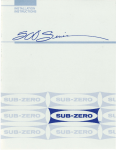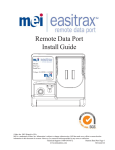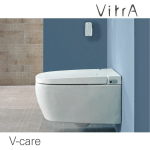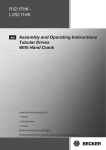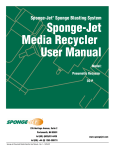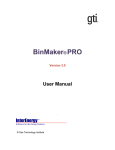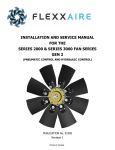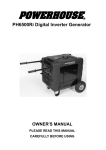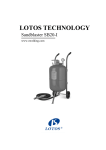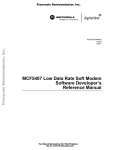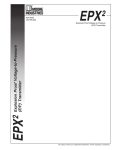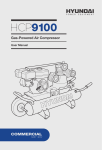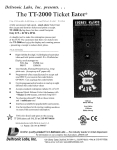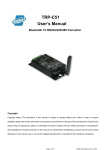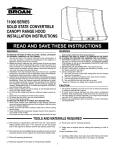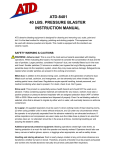Download Dual Inv Gen & Comp User Manual English
Transcript
Generator/Air Compressor 2 in 1 Owner’s Manual Thank you for purchasing our generator/air compressor. This manual provides information regarding the operation and maintenance of this product. Please read this manual befor e using this product. We have made every effort to ensure the accuracy of the information in this manual. We reserve the right to change this product at any time without prior notice. Please keep this manual available to all users during the entire life of the generator. TABLE OF CONTENTS 1. GENERAL SAFETY PROCEDURE……………………………………3 2. COMPONENTS………………………….………………………….6 3. PREPARING THE UNIT FOR USE………………………….................7 4. STARTING THE UNIT…………………………………………...……..12 5. USING THE GENERATOR/AIR COMPRESSOR.... ………………..……..13 6. STOPPING THE GENERATOR/AIR COMPRESSOR..…………...….……15 7. MAINTENANCE / CARE………………………………….……….…15 8. STORAGE / TRANSPORT PROCEDURES.………………..…………..... 20 9. TROUBLESHOOTING FOR GENERATOR………………………...…….21 10. TROUBLE SHOOTING FOR AIR COMPRESSOR…………………….…22 11. SPECIFICATIONS..………………….………………….……………23 12. WIRNG DIAGRAM FOR MODEL WITH/WITHOUT DC…..…..……….... 24 13.EXPOILED VIEW DARAWING...……………………………………… 26 14. PARTS LIST…………………….……………………………..………....27 2 1. GENERAL SAFETY PROCEDURE Please familiarize yourself with the following safety symbols and words: The safety alert symbol is used with one of the safety words (DANGER, CAUTION, or WARNING) to alert you to hazards. Please pay attention to these hazard notices both in this manual and on the generator. DANGER: Indicates a hazard that will result in serious injury or death if instructions are not followed. WARNING: Indicates a strong possibility of causing serious injury or death if instructions are not followed. CAUT ION: Indicates a possibility of personal injury or equipment damage if instructions are not followed. DANGER: This unit produces poisonous carbon monoxide gas when running. This gas is both odorless and colorless. Even if you do not see or smell gas, carbon monoxide may still be present. Breathing this poison can lead to headaches, dizziness, drowsiness, and eventually death. • • Use outdoors ONLY in non-confined areas. Keep at least of 1 meter clearance on all sides to allow proper ventilation of the generator. WARNING: This unit may emit highly flammable and explosive gasoline vapors, which can cause severe burns or even death. A nearby open flame can lead to explosion even if not directly in contact with gas. • Do not operate near open flame. • Do not smoke near the unit. • Always operate on a firm, level surface. • Always turn unit off before refueling. Allow unit to cool for at least 2 minutes before removing fuel cap. Loosen cap slowly to relieve pressure in tank. • Do not overfill gas tank. Gas may expand during operation. Do not fill to the top of the tank. • Always check for spilled gas before operating. • Empty gasoline tank before storing or transporting the unit. • Before transporting, turn fuel valve to off and disconnect spark plug. 3 WARNING: The generator of this unit produces powerful voltage, which can result in electrocution. • ALWAYS ground the generator before using it (see the “Ground the Generator” portion of the “PREPARING THE UNIT FOR USE” section). • Generator should only be plugged into electrical devices, either directly or with an extension cord. NEVER connect to a building electrical system without a qualified electrician. Such connections must comply with local electrical laws and codes. Failure to comply can create a backfeed, which ma y result in serious injury or death to utility workers. • Use a ground fault circuit interrupter (GFCI) in highly conductive areas such as metal decking or steel work. GFCIs are available in-line with some extension cords. • Do not use in rainy or wet conditions. • Do not touch bare wires or receptacles (outlets). • Do not allow children or non-qualified persons to operate. WARNING: This unit produces heat when running. Temperatures near exhaust can exceed 150o F (65 o C). • Do not touch hot surfaces. Pay attention to warning labels on the generator denoting hot parts of the machine. • Allow the unit to cool several minutes after use before touching engine or areas which heat during use. • Plug individual appliances into the unit using heavy-duty, outdoor-rated cords with a wire gauge adequate for the appliance load. Overloaded cords can cause fires or equip ment damage. Don't use extension cords with exposed wire s or worn shielding. Make sure the cords from the generator don't present a tripping hazard. Don't run cords under rugs where heat might build up or cord damage may go unnoticed.” CAUTION: Misuse of this unit can damage it or shorten its life. • Use this unit only for its intended purposes. • Operate only on dry, level surfaces. • Allow generator to run for several minutes before connecting electrical devices. • Shut off and disconnect any malfunctioning devices from generator. • Do not exceed the Wattage capacity of the generator by plugging in more electrical devices than the unit can handle. • Do not turn on electrical devices until after they are connected to the generator. • Turn off all connected electrical devices before stopping the generator. WARNING: l Shut off the compressor, disconnect air hoses, release air pressure from the tanks, and allow the compressor a nd engine to cool before performing any maintenance on this tool. l Adjust the Regulator to a pressure that does not exceed the maximum operating pressure for your tool. Do not connect an air tool to this compressor if the regulator is set for a higher press ure than the maximum recommended pressure for that tool. 4 l l l l l l l Do not remove or modify the factory installed Control Valve Assembly Do not remove or modify the Safety Valve. Open the Drain Valves every day after use. Water will accumulate in the tanks, and if not drained can cause corrosion on the inside of the tanks. Corrosion may weaken the tanks. Do not open the Drain Valves more than four full turns. If more than 4 threads are showing, the drain valves may be damaged or may blow out of the tank. Do not attempt to repair or modify the Air Tanks. Welding, drilling or otherwise modifying the tanks may weaken them and potentially cause leaks or explosion. The compressor and engine are a source of ignition when they are running, and after operation until they have cooled off. Do not spray or spill flammables in the area of this tool. Flammables such as spray paint, solvents, gasoline, etc. may ignite or explode if sprayed or spilled near or on this compressor or engine. This compressor and engine will create loud and prolonged noise when in operation. Do not remain near the compressor when it is in operation without appropriate hearing protection. Wear ANSI-approved hearing protection equipment when working near this compressor. In addition to the above safety not ices, please familiarize yourself with the safety and hazard markings on the unit 5 2. COMPONENTS (1)Engine Switch-Use to start/stop engine (2)Compressor Switch – Select to start and stop the compressor (3) Circuit Breaker24A- Push buttons that protect the generator from electrical overload. (4)Circuit Breaker 20A - Push buttons that protect the generator from electrical overload. (5) 120 V Receptacles- To connect electrical devices that run 120 Volt, 60 Hz, single phase, AC current. (6) 120V Twistlock receptacle (7)Indicators-Output indicator, overload alarm indicator, low oil alarm indicator. (8) Ground Terminal- Connect grounding wires here to properly ground unit. (9) Choke Lever- Adjusts the amount of air let into the engine. (10)Fuel Valve- Allows fuel to enter engine. (11) Recoil Starter- Pull-cord for starting engine. (12) Fuel Cap - Access to the fuel tank for adding fuel. (13) Fuel Gauge - Indicates the amount of fuel in the tank. (14)Tank Pressure Gauge – Indicate s the pressure in side the tank (15)Output Pressure Gauge – Indicates the output pressure (16)Handle Lock – Use to lock the handle (17)Pressure Regulator – Use to regulate the output pressure (18)Connector – Use to connect the air hose for the air tools (19) Spark Plug- Provides proper engine ignition. (20) Oil Fill and Dipstick- Location for checking and f illing engine oil. (21)Pressure Switch – Use to control the cut out pressure (22) Air Cleaner- a removable, cleanable, sponge-like element that limits the amount of dirt pulled into the engine. (23)Drain Valve- Use to drain out the water and dust inside the tank (24)Safety Valve - Use to release the tank pressure so as to prevent the tank from bursting (25) DC terminal : only for connecting 12V DC device (26) DC fuse -To protect DC from overload. 6 3. PREPARING THE UNIT FOR USE If you are using the unit for the first time, there are a few steps you must take to prepare it for operation: Step 1 – Attach the wheels and foot bracket 1: Find the wheels, wheel axle, and cotter pin 2: Insert the axle to the wheels (see figure 1) 3: Insert the cotter pin to the end of the axle (see figure 2) 4: Attach other end of the axle and wheel to the frame, insert the cotter pin to the hole on the frame.(see figure 3) 5: Repeat the four steps above to add the other wheel Figure 1 Figure 2 Figure 3 6: Find the foot bracket.(see figure 4) 7: Attached the foot bracket to the bottom of the frame by screwing it inside, then fasten it by using the wrench. Figure 4 Figure 5 Step 2- Add engine oil This unit requires engine oil to operate properly. The unit, when new from the package, contains no oil in the crankcase. You must add the proper amount of oil before operating the unit for the first time. This amount, which is equal to the oil capacity of the engine crankcase, can be found on the chart in figure 6. When filling the engine with oil in the future, please refer to this chart. GC3012HiD 600ml Model number Engine Oil capacity Figure 6- Engine Oil Capacity For general use, we recommend SAE 15W/40 4-stroke motor oil to fill the engine crankcase. 7 To add oil, follow these steps: 1. Make sure the unit is on a level surface. 2. Remove the back cover of the unit by unscrewing the two bolts on the back cover as shown in figure 7 3. Unscrew the oil filler/dipstick cap from the engine as shown in figure 8. 4. Using a funnel, add the appropriate amount of oil, as found in figure 6, into the crankcase. You will know the crankcase is full when the oil level has reached the lower lip of the opening you have just poured the oil into (see figure 9). 5. Replace oil filler cap. 6. Attached the back cover to the unit and screw the two bolts NOTE: Engine oil need to be added before you use this product, either for generator use or air compressor use. O pen Housing Figure 7 – Removing the back cover Figure 8- Unscrewing the oil cap Figure 9- Adding oil Step 3-Add oil for air compressor The air compressor of this unit requires oil to operate properly. You must add the proper amount of oil before operating the air compressor for the first time. This amount, which is equal to the oil capacity of the air compressor crankcase, can be found on the chart in figure 10. When filling the engine with oil in the future, please refer to this chart. Model number Oil capacity for Air compressor GC3012HiD 270ml Figure 10- Oil Capacity for air compressor For general use, we recommend SAE 15W/40 4-stroke motor oil to fill the air compressor crankcase. 1. Make sure the unit is on a level surface. 2. Remove the right cover of the unit by unscrewing the two bolts on the back cover as shown in figure 11 3. Unscrew the oil breather from the engine as shown in figure 12. 8 4. Using a funnel, add the appropriate amount of oil, as found in figure 10, into the crankcase. Oil capacity should be between the “LOW” and “FULL” mark on the oil level indicator (see figure 13). Do not ove rfill the crankcase. 5. Attached the back cover to the unit and screw the two bolts Open Housing Figure 11 Figure 12 Figure 13 Step 4- Add Gasoline WARNING: Gasoline and gas fumes are highly flammable. • Do not fill tank near an open flame. • Do not overfill. Always check for fuel spills. To ensure that the unit runs smoothly use only FRESH, UNLEADED GAS WITH AN OCTANE RATING OF 87 OR HIGHER. To add gasoline: 1. Make sure the unit is on a level surface. 2. Unscrew gas cap and set aside (NOTE: the gas cap may be tight and hard to unscrew). 3. Slowly add unleaded gasoline to the fuel tank. Be careful not to overfill. Please refer to the chart in figure 14 to find the gas capacity of your unit model. The fuel gauge on the top of the unit indicates how much gasoline is in the generator gas tank. NOTE: Gas can expand. Do not fill the gas tank to the very top. 4. Replace fuel cap and wipe up any spilled gasoline with a dry cloth. IMPORTANT: • Never use an oil/gasoline mixture. • Never use old gas. 9 • • Avoid getting dirt or water in the fuel tank. Gas can age in the tank and make it hard to start up the generator in the future. Never store generator for extended periods of time with fuel in the tank. GC3012HiD 14 L (3.96 gallons) Model number Gas tank capacity Figure 14- Gas Tank Capacity Step 5- Ground the Generator of this unit WARNING: Failure to properly ground the generator can result in electrocution. Ground the generator by tightening the grounding nut against a grounding wire (see figure 15). A generally acceptable grounding wire is a No. 12 AWG (American Wire Gauge) stranded copper wire. This grounding wire should be connected at the other end to a copper or brass grounding rod that is driven into the earth. Grounding codes can vary by location. Please contact a local electrician to check the grounding regulations for your area. Figure 15- Grounding nut location Subsequent Use of the Generator If this is not your first time using the generator there are still steps you should take to prepare it for operation. IMPORTANT: At this point you should be familiar with the procedures described in the first portion of this section entitled “Using the Generator for the First Time.” If you have not yet read this section, go back and read it now. Step 1- Check the Oil I: Check the oil for generator The generator is equipped with an automatic shutoff to protect it from damage due to low oil. Nonetheless, you should check the oil level of the engine before each use to ensure that the engine crankcase has a sufficient amount. To check the oil level: 1. Make sure the generator is on a level surface. 10 2. Unscrew the oil filler/dipstick cap. 3. With a dry cloth, wipe the oil off of the stick on the inside of the cap. 4. Insert the dipstick as if you were replacing the cap and then remove again. There should now be oil on the stick. If there is no oil on the stick, or oil only at the very end of the stick, you should add oil until the engine crankcase is filled 5. Be sure to replace cap when finished checking oil. NOTE: The oil capacity for your generator can be found in the “Specifications” section of this manual II: Check the oil for air compressor Check the oil indicator to see if the oil level is within the required range, add oil if the oil level is low. (see figure 13) Step 2 – Check the Gas Level Before starting the generator, check to see that there is sufficient gasoline in the gas tank. The fuel gauge on top of the generator will indicate the gas level in the tank. Add gas if necessary according to the steps in the “Adding Gasoline” portion of the “Maintenance” section. WARNING: Gasoline and gasoline fumes are highly flammable. • Do not fill tank near an open flame. • Always allow engine to cool for several minutes before refueling. • Do not overfill (check the “Specifications” section for the tank capacity of your generator). Always check for fuel spills. IMPORTANT: • Use only UNLEADED gasoline with an octane rating of 87 or higher. • Do not use old gas. • Never use an oil/gasoline mixture. • Avoid getting dirt or water in the fuel tank. • Never store generator for extended periods of time with fuel in the tank. Step 3- Ground the Generator WARNING: Failure to properly ground the generator can result in electrocution. Ground the generator by tightening the grounding nut against a grounding wire (see figure 6). A generally acceptable grounding wire is a No. 12 AWG (American Wire Gauge) stranded copper wire. This grounding wire should be connected at the other end to a copper or brass grounding rod that is driven into the earth. Grounding codes can vary by location. Please contact a local electrician to check the grounding regulations for your area. Step 4- Check the safety Valve 11 Pull the ring on the safety valve to make sure that the safety valve operates freely. If the valve is stuck or does not operate smoothly, it must be replaced with the same type of valve. 4. STARTING THE UNIT Before starting the unit, make sure you have read and performed the steps in the “Preparing the Generator for Use” section of this manual. CAUTION: Disconnect all electrical loads from the generator before attempting to start. To start your generator/air compressor, perform the following steps: 1. Make sure no electrical devices are connected to the generator. Such devices can make it difficult for the engine to start. 2. Check that the generator is pr operly grounded (see section “Ground the Generator”). 3. Turn the fuel valve to the “on” position (see figure 16). 4. Move the choke rod to the “closed” position (see figure 17). 5. Set the engine switch to the “on” position. 6. Pull on the recoil starter handle slowly until a slight resistance is felt (see figure 18). Then pull quickly to start the engine. Return cord gently into the machine. Never allow the cord to snap back. 7. If engine fails to start, adjust the position of the choke rod and repeat step 6. NOTE: After repeated attempts to start the engine, please consult the troubleshooting guide before attempting again. If problems persist please contact the dealer. 8. Once the engine has started and run for about a minute, move the choke rod about half way towards the “open” position. Wait another 30 seconds and then move the choke rod all the way to the “open” position. 9. Allow the generator to run for several minutes before attempting to connect any electrical devices. Figure 16- Fuel Valve in the “on” position Figure 17- Choke in the “closed” position C start handle Figure 18- Pulling the start cord 12 5. USING THE GENERATOR / AIR COMPRESSOR This Unit has three working mode. You can run the generator singly, run the air compressor singly and run them together. I: Air Compressor working mode After the unit is started, select the compressor selector to on position (see figure 19) and not to plug in any electrical device, then this unit runs with only the air compressor working. II: Generator working mode After the unit is started and the air tank is loaded with a full tank of air, select the compressor selector to off position (see figure 20), then this unit runs with only the generator working. Allow the engine to run for several minutes and plug in the electrical device to the voltage outlet. NOTE: Air tank need to be pumped with a full tank of air before select the compressor to off position. III: 2 in 1 mode Select the compressor selector to on position (see figure 19), allow the engine to run for several minutes, and plug in the electrical device to the voltage outlet. You can run the generator and air compressor together. Figure 19 Figure 20 CAUTION: Please familiarize yourself with the markings on the panel before connecting electrical devices. You may connect electrical devices running on AC current according to their wattage requirements. The rated wattage corresponds to the maximum wattage the generator can output on a continuous basis. Model Number Rated(Running) Wattage GC3012HiD 2600 Figure 21- generator wattage The total running wattage requirement of the electrical devices connected to the generator should not exceed the rated wattage of the generator itself. To calculate the total wattage requirement of the electrical devices you wish to connect, find the rated (or running) wattage of each device. 13 This number should be listed somewhere on the device or in its instruction manual. If you cannot find this wattage, you may calculate it by multiplying the Voltage requirement by the Amperage drawn: Watts= Volts x Amperes Once you have found the rated wattage requirement of each electrical device, add these numbers to find the total rated wattage you wish to draw from the generator. If this number exceeds the rated wattage of the generator, DO NOT connect all these devices. Select a combination of electrical devices, which has a total rated wattage lower than or equal to the rated wattage of the generator. CAUTION- The generator can run at its surge wattage capacity for only a short time. Connect electrical devices requiring a rated (running) wattage equal to or less than the rated wattage of the generator. Never connect devices requiring a rated wattage equal to the surge wattage of the generator. 5.1 Steps of Using the generator 1.Start the engine and make sure the output indicator (green) comes on and other red light are off. 2. Make sure that the appliance to be used is switched off, and plug in the appliance. 5.2 Output and Overload Indicators, low engine oil Indicator The out indicator light (green) will remain ON during normal operating conditions. If the generator is overloaded, or if there is a short in the connected appliance, the output indicator light (green) will go OFF, the overload indicator light (red) will go ON and current to the connected appliance will be cutted off. Stop the engine if the overload indicator light (red) comes ON and check overload reason Check engine oil if the oil indicator (Red) turns ON. NOTE: n Before connecting an appliance to the generator, check that it is in good order, and that its electrical rating does not exceed that of the generator. Then connect the power cord of the appliance, and start the engine. n When an electric motor is started, both the overload indicator light (red) and the output indicator light (green) lights may go on simultaneously. This is normal if the overload indicator light(red) goes off after about four (4) seconds. If the overload indicator light(red) stays on, please contact with the dealer. 5.3 Low oil alert system The low oil alert system is designed to avoid the damage of engine due to insufficient oil inside the crankcase. The low oil alert system is actuated and automatically shut off the engine when the oil level is about to be lower than the safety level. When the low oil alert system is actuated, low oil indicator (Red) flashes if the operator attempts to start the engine again, in this case the engine could not be started. ADD OIL! 14 6. STOPPING THE GENERATOR/AIR COMPRESSOR To stop this unit: 1. Turn off, then unplug all connected electrical devices. 2. Allow the unit to run for several more minutes with no electrical devices connected. This helps stabilize the temperature of the generator. 3. Set the engine switch to the “off” position. 4. Turn the fuel valve to the “off” position. 5. Open the drain valve to drain out the air and water WARNING: Allow the generator to cool for several minutes before touching areas that become hot during use. CAUTION: Allowing gas to s it in the generator tank for long periods of time without use can make it difficult to start the generator in the future. Never store generator for extended periods of time with fuel in the tank. 7. MAINTENANCE / CARE Proper routine maintenance of your generator will help prolong the life of your machine. Please perform maintenance checks and operations according the schedule in figure 22. CAUTION: Never perform maintenance operations while the unit is running. Recommended Maintenance Schedule each use Engine oil Compressor oil check level Engine Air cleaner fuel filter cup every every month months or months or year or or 20 hrs 50 hrs 100 hrs 300 hrs x x replace check every 6 x replace check level every 3 x x clean x clean x spark plug check/ clean x gas tank check gas level x clean Safety Valve Ring x check each week Figure 22- Recommended maintenance schedule 15 Cleaning the Gene rator/Air compressor Always try to use your generator/air compressor in a cool dry place. In the event your generator becomes dirty you may clean the exterior with one or more of the following: - a damp cloth a soft brush a vacuum pressurized air Never clean your generator/air compressor with a bucket of water or a hose. Water can get inside the working parts of the generator and cause a short circuit or corrosion. Checking the Oil The generator is equipped with an automatic shutoff to protect it from running on low oil. Nonetheless, you should check the oil level of the generator before each use to ensure that the generator crankcase has a sufficient amount. To check the oil level: 1. Make sure the generator is on a level surface. 2. Unscrew the oil filler/dipstick cap (see figure 23). 3. With a dry cloth, wipe the oil off of the stick on the inside of the cap. 4. Insert the dipstick as if you were replacing the cap and then remove again. There should now be oil on the stick. If there is no oil on the stick, or oil only at the very end of the stick, you should add oil until the engine crankcase is filled. See “Changing/ Adding Oil” in this section. 5. Be sure to replace cap when finished checking oil. 6. Check the oil level of the air compressor by watching if the oil level is with in the range between “low” and “full” mark (see figure 23). If it is below the “low” mark, you should add the oil until the compressor crankcase is filled. See “Changing/ Adding Oil” in this section. Oil filler cap Oil filler hole Figure 23- Checking the oil 16 Changing/ Adding Oil Changing/Adding oil for generator You should check the oil level of your generator according to the maintenance schedule in figure 22. When the oil level is low you will need to add oil until the level is sufficient to run the generator. The oil capacity of your generator engine is listed in figure 24. Model number Engine oil capacity GC3012HiD 600ml Figure 24- Engine Oil Capacity. It is only necessary to drain the oil from the crankcase if it has become contaminated wit h water or dirt. In this case, you can drain the oil from the generator according to the following steps: 1. Place a bucket underneath the generator to catch oil as it drains. 2. Remove the back cover of this unit. 3. Using a 10 mm hex wrench, unscrew the oil drain plug, which is located on the crankcase underneath the oil filler/dipstick cap (see figure 25). Allow all the oil to drain from the generator. 4. Replace the oil drain plug and tighten with a 10 mm hex wrench. To add oil to the engine crankcase, follow these steps: 1. Make sure the generator is on a level surface. 2. Unscrew the oil filler/dipstick cap from the engine as shown in figure 14 above. 3. Using a funnel, add high detergent motor oil to the crankcase. We recommend SAE 30W 4-stroke motor oil for general use. When full, the oil level should come close to the top of the oil fill opening (see figure 26). Filler cap Drain plug Figure 25- Draining oil Figure 26- Adding oil NOTE: Never dispose of used motor oil in the trash or down a drain. Please call your local recycling center or auto garage to arrange oil disposal. Changing/Adding oil for generator You should check the oil level of the compressor according to the maintenance schedule in figure 22. When the oil level is low you will need to add oil until the level is sufficient to run the generator. 17 The oil capacity of your generator engine is listed in figure 27. 1. 2. 3. 4. 5. GC3012HiD Model number 270ml Compressor oil capacity Figure 27 Make sure the unit is on a level surface. Remove the right cover of the unit by unscr ewing the two bolts on the back cover as shown in figure 28 Unscrew the oil breather from the engine as shown in figure 29. Using a funnel, add the appropriate amount of oil, as found in figure 10, into the crankcase. Oil capacity should be between the “LOW” and “FULL” mark on the oil level indicator (see figure 23). Do not overfill the crankcase. Attached the back cover to the unit and screw the two bolts Open Housing Figure 28 Figure 29 Air Cleaner Maintenance Routine maintenance of the air cleaner helps maintain proper air flow to the carburetor. Occasionally check that the air cleaner is free of excessive dirt. 1. 2. 3. 4. 5. 6. Unscrew the 4 bolts of the air cleaner cover (see figure 30). Remove the sponge -like elements from the casing. Wipe the dirt from inside the empty air cleaner casing Wash the sponge -like elements in household detergent and warm water. Allow to dry. Soak the dry elements in engine oil. Squeeze out any excess oil. Replace the sponge -like elements in the air cleaner casing and replace the cover. 18 Figure 30- Removing the air cleaner casing. Spark Plug Maintenance The spark plug is important for proper engine operation. A good spark plug should be intact, free of deposits, and properly gapped. To inspect your spark plug: 1. Pull on the spark plug cap to remove it. 2. Remove the back cover of the generator. 3. Unscrew the spark plug from the generator using the spark plug wrench included with this product (see figure 31). 4. Visually inspect the spark plug. If it is cracked or chipped, discard and replace with a new spark plug. We recommend using a spark plug such as F7RTC-LG. 5. Measure the plug gap with a gauge (see figure 32). The gap should be 0.7-0.8mm (0.028-0.031in). 6. If you are re-using the spark plug, use a wire brush to clean any dirt from around the spark plug base and then re-gap the spark plug.. 7. Screw the spark plug back into its place on the generator using the spark plug wrench. Replace the spark plug cap. 19 Figure 31- Removing the spark plug Figure 32- Measuring the spark plug gap Emptying the Gas Tank Before storing your generator for extended periods of time, you should drain your generator of gasoline. To drain the generator of gas: 1. Turn the fuel valve to the “off” position. 2. Remove the fuel filter cup (see “Fuel Filter Cup Cleaning” earlier in this section). 3. Empty the fuel filter cup of any fuel. 4. With a receptacle underneath the generator to catch the gas, turn the fuel valve to the “on” position. Drain all the gas from the generator. 5. Turn the fuel valve to the “off” position. 6. Replace the fuel filter cup. 7. Store the emptied gasoline in a suitable place. CAUTION: Do not store fuel from one season to another. 8. STORAGE / TRANSPORT PROCEDURES CAUTION: Never place any type of storage cover on the generator while it is still hot. When transporting or storing your generator for extended periods of time: • Empty the gas tank (see “Emptying the Gas Tank” in the “Maintenance” section). • Disconnect the spark plug. • Do not obstruct any ventilation openings. • Keep the generator in a cool dry area. 20 9. TROUBLESHOOTING FOR GENERATOR If the engine do not start, please check N If any fuel in the tank Add fuel Y N Turn the switch to on position If engine switch is no? Y N If fuel valve is on? Turn on the valve Y N Add oil If enough oil in the engine? Y If spark from the spark plug No spark N Contac the authorized Replace plug dealer How to check: 1) Remove the spark plug cap and clean Be sure there is no spilled fuel around any dirt from around the spark plug. the spark plug. Spilled fuel may 2) Remove the spark plug and install the spark ignite. plug in the plug cap. 3) Set the plug side electrode on the cylinder head to ground. 4) Crank the engine, sparks should jump across the gap. Warning If the fuel reaches carburetor How to check : 1) Turn off the fuel valve and lossen the drain screw. If the engine still does not 2) Fuel should flow from the drain when start, contact the authorized the fuel valve is turned on. dealer. If the appliance does not operate, please check If the output indicator is ON? N N If the overload indicator light is ON? Contact the authorized dealer Y Y Check the electrical appliance or equipment for any N defects. 21 Contact the authorized dealer 10. TROUBLE SHOOTING FOR AIR COMPRESSOR Problem Cause Correction No indication on the pressure Magnetic valve is not on Select the circuit breaker to on Pressure switch is at off position position Select the pressure switch to on gauge position Inlet and outlets valve plate are installed wrong Install the inlet and outlet valve plates again Crankshaft, damage Replace connecting rod Pressure gauge reading too Pressure switch is set too high high Pressure switch not work Pressure switch trip when the compressor is at off position Reset the pressure value of the pressure switch Air cleaner not in good condition Replace Magnetic wrong Connect the magnetic valve again valve is connected Pressure switch damage Replace Air cleaner damage Replace air cleaner Air flowing system leakage Check and fasten fitting and sealing of the air flowing system Oil leakage at the end cap Leaking gasket Replace the rubber gasket No pressure output when the Magnetic valve damage Replace compressor selector is at on position. 22 11.SPECIFICATIONS Generator Condition Air compressor working mode 2 in 1 mode 2.6 / 1.8 DC Output (Optional) 12V/8A 12V/8A 12V/8A Rated Frequency( Hz) 60 / 60 Rated Voltage ( V) 120 / 120 Rated Amperage ( A) 23.3 / 15 Rated Speed( r/min) 3600 / 3600 Air Tank Capacity( Gallon) / 3.5 3.5 Cut-In Pressure( PSI) / 90 90 Cut-Out Pressure( PSI) / 125 125 4.1SCFM 4.1SCFM 5.0SCFM 5.0SCFM Type Generator working mode Rated Output( kW) 90PSI / Air Compressor Flow 40PSI / Engine Model No. Engine Type Displacement( Bore x Stroke ) Compression Ratio Rated Power? kW/(r/rpm)? Rated speed( rpm) Ignition Type Spark Plug Starting Mode Fuel Type Fuel Consumption Rate( g/kW.h) Oil Type 170F OHV 208cc 8.5:1 3.8/ 3600 3600 TCI F7RTC-LG Recoil Start 90# 385g/kWh 15W/40 Fuel Tank Capacity( L) Dimension( Length x Width x Height) (mm) Net Wight? kg? 14 458X584X472 55 23 12.WIRNG DIAGRAM FOR MODEL WITH DC 24 WIRNG DIAGRAM FOR MODEL WITHOUT DC 25 13. EXPOILED VIEW DRAWING 26 14. PARTS LIST Item No. Description Qty Item No. Description Qty 1 Air Tank Assembly 1 40 1/4 Connect 1 2 Drain Valve 2 41 Regulator 1 3 Check valve 1 42 Pressure Gauge Base 1 4 Safety valve 1 43 Pressure Gauge 2 5 Elbow 2 44 High Block 2 6 Flange Bolt M8*16 2 45 Engine Base Support II 1 7 Socket head screw M8*10 1 46 Flange Bolt M6*40 2 8 Spring washer? 8 3 47 Spring 1 9 Plain washer? 8*20*2 1 48 Rubber Plug 1 10 Pressure switch connecting 1 49 End Cap 1 11 Elbow 9 50 O-Ring 2 12 Shield A 1 51 Piston 1 13 Splitpin 4 52 Pressure adjusting spring 1 14 Wheel 2 53 Regulator cover 1 15 Axle 2 54 Flange Bolt M5*16 4 16 M8 Nut 8 55 Quick Connector 2 17 Frame 1 56 Invertor Baffle 1 18 Frame Support 2 57 Invertor Bracket 1 19 Plain washer ? 8*24*2 2 58 Engine 1 20 Rubber Foot 2 59 Seal 1 21 Plain washer? 6*18*2 2 60 Pump Crankcase 1 22 Flange Bolt M6*20 2 61 Crack Shaft 1 23 Control panel Assy 1 62 Socket head screw M6*20 1 24 Flange Bolt M6*12 12 63 Flange Bolt M8*16 4 25 Paper washer? 6 10 64 Rubber Seal 1 26 Solenoid Valve 1 65 End Cover 1 27 Plug Screw 2 66 Plain Washer ? 6 8 28 Socket head screw M4*15 2 67 Flange Bolt M8*20 4 29 Air Filter 1 68 Cross recess panheadscrew M5*10 1 30 Pressure switch 1 69 Connecting Rod 1 31 Shield B 1 70 Check Ring 2 32 Bumper A, Engine 1 71 Piston Pin 1 33 Bumper B, Engine 1 72 Piston 1 34 Plain washer ? 8 4 73 Oil Ring 1 35 Engine Base Support I 1 74 Compression Ring 2 36 Bolt M8*40 2 75 Cylinder gasket 1 37 Engine Base 1 76 Socket head screw M8*30 2 38 Invertor 1 77 Cylinder 1 39 Tee Joint 1 78 Valve plate gasket 1 27 Item Description No. Qty Item Description No. Qty 79 Valve Plate 2 89 Handle 1 80 Valve 2 90 Rubber Nut M12 2 81 Metal gasket 1 91 Plain Washer ? 16 4 82 Head gasket 1 92 Handle connecting rubber 2 83 Male Coupling 1 93 Fuel Tank Assy 1 84 Cylinder Cap 1 94 Flange Bolt M6*30 4 85 Spring Washer ? 6 4 95 Plain washer? 6*20*2 4 86 Socket head screw M6*50 4 96 Bumper C, Engine 1 87 handle rod 1 97 Bumper D, Engine 1 88 handle lock 1 28





























